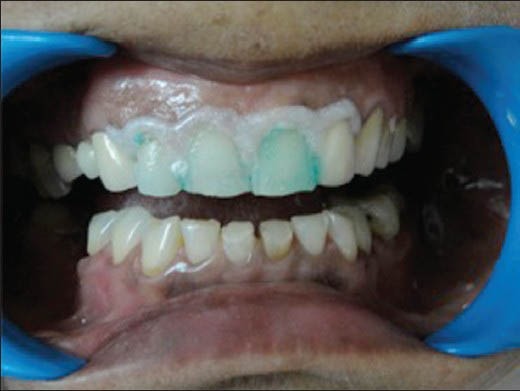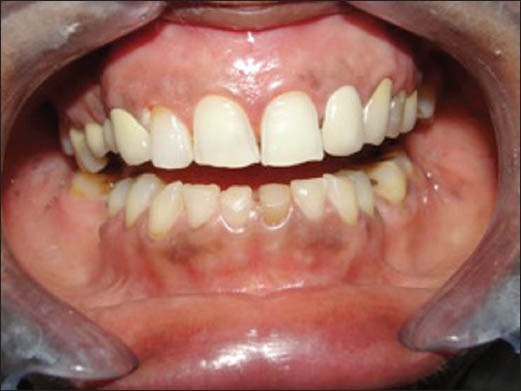Abstract
Intrinsic discoloration of a non-vital permanent incisor tooth due to trauma may have a significant esthetic and social impact on children and adolescents. Treatment options for discolored Non-vital teeth are bleaching, crowns or veneers. However, this restorative crown or veneer approach has a significant drawback of being an invasive technique. Intervention should be minimal destruction of tooth structure and should not compromise future restorative options. The advantage bleaching over crown is that it offers simple conservative approach in removal of stain and whitening discolored teeth without damaging tooth structure.
Keywords: Bleaching, crown, endodontic treated tooth, non-vital, tooth discoloration, veneers
INTRODUCTION
Aesthetics and color of the teeth are reflection of systemic health. Several intrinsic and the extrinsic factors can influence tooth color.[1] While intrinsic discoloration of the tooth may be caused following trauma, loss of vitality, endodontic treatment, and restorative procedures apart from known local and systemic factors.[2,3,4] Extrinsic tooth stains occur due to poor tooth brushing techniques, smoking, dietary intake of tannin-rich foods, excess use of chlorhexidine mouth wash, and/or consumption of metal salts.[1,5]
Many techniques have been evolved for the purpose of managing discolored non-vital tooth.[6] Amongst these techniques, inside/outside bleaching technique is an effective and conservative treatment option compared to placing restorations.[7,8,9] In this technique, bleaching is carried out within the tooth and on the outside of the tooth simultaneously. Here, we report a case wherein we have used this technique with improved results.
CASE REPORT
A 30-year-old female patient reported to the institution with a complaint of discolored upper front tooth and desired the discolored tooth be treated [Figure 1]. On examination, maxillary right central incisor tooth was structurally intact and firm. Mild surface abrasion and vitality test was negative. Intra oral periapical radiograph with maxillary left central incisor revealed a complete root canal obturation without periapical pathology. Patient was explained about the bleaching procedure and consented for the inside and outside in-office power bleaching therapy to correct discolored tooth.[10]
Figure 1.

Discolored maxillary left central incisor tooth
Method of inside and outside in-office power bleaching
Using rubber dam, the tooth to be bleached was isolated and cleaned with pumice and the shade was recorded [Figure 2]. The obturated material was removed from the tooth up to 2 mm below the gingival margin. Stains in the pulp chamber were removed using round bur with the minimal distruction. 1 mm glass ionomer cement (type 1, GC Corporation, Singapore) was placed over the gutta-percha. Using 37% phosphoric acid, pulp chamber was etched for 30-60 s, washed and dried, which resulted in the opening of dentinal tubules. Following this, 38% hydrogen peroxide (pola office ultradent, USA), bleaching agent was mixed into thick paste and placed immediately in the pulp chamber and on the external labial surface of the tooth [Figure 3]. After 10-15 min, the tooth was cleansed and the residue bleach inside was removed with water using a high suction unit. The procedure was repeated four times. Following the final wash, tooth shade was evaluated, which matched with adjacent tooth and satisfactory results were achieved [Figure 4]. The access and the partially empty pulp chamber were restored using tooth colored composite resin.
Figure 2.

Internal and external bleaching in progress
Figure 3.

Guma barrier applied for external bleaching
Figure 4.

Post bleaching appearance of the discolored teeth
DISCUSSION
Different options are used in the treatment of discolored endodontically treated anterior tooth.[6] In-office, the bleach has many advantages over the conventional options and is especially, useful in treating the crown and intrinsic discoloration of the tooth. The in-office bleach, which was used in this patient, is discussed here. For a tooth that had discolored following de-vitalization, bleaching is preferable to the crown placement when the tooth is relatively intact.[11] In vitro studies suggested that it is the bulk of the remaining tooth structure rather than the dowel that provides strength and resistance to fracture of the endodontically treated tooth.[12]
A previous study reported no significant difference in the success rate achieved between anterior non-vital teeth with and without crowns.[13] Thus, supporting our view that endodontically treated anterior teeth do not require crowns.[14] Trabert et al. also concluded no appreciable difference in the resistance to fracture between untreated anterior teeth and endodontically treated anterior teeth.[12] Further despite small proximal restorations, most pulp less anterior teeth with sound coronal tooth structure can be conservatively restored with the lingual composite restoration.[15] Interestingly, there was no advantage in reinforcement by cementing posts in endodontically treated anterior teeth.[16] In contrast placement of a dowel and crown in such a tooth is likely to weaken rather than strengthening it. For instance, intact endodontically treated anterior teeth with natural crowns demonstrate greater strength against fracture than teeth built-up with pin retained amalgam cores or cast gold dowel cores. Further central incisors were three times more resistant to fracture than the teeth, which were restored with dowel core and crowns.[17]
A laminate veneer may offer a less destructive alternative to the crown. It may mask the discoloration, but also may undergo fracture, debonding, and marginal leakage. However, it requires tooth preparation and is irreversible.[18]
Considering the above reasons in-office bleaching was planned on this patient and desirable results were achieved with patient satisfaction. The major advantage of this approach is (1) it is more conservative (2) more effective in stain removal and (3) significantly improves the appearance of tooth color. Hence, In-office bleaching should be the most commonly adapted method by the dentist as it provides complete control on the process throughout treatment.[19] Moreover, in-office bleaching is usually a rapid process and the results are evident even after a single intervention. Nevertheless, many of the patients prefer this bleaching approach by the dental professional because it requires less active participation on their part. Pola office ultradent xtra boost containing 38% hydrogen peroxide chemically activated without light and heat was used in the current procedure. This dental bleach is extensively used and is well-documented.[20,21] Hydrogen peroxide releases oxygen that breaks down conjugated bonds associated with the stains into a single bond, which in turn can be washed out with water and hence effectively removes the stains. This leads to more absorption of color wavelengths, resulting in tooth whitening effect. The use of light in bleaching had no demonstrable benefit over the chemically activated tooth whitening system.[22]
CONCLUSION
Anterior tooth trauma, with or without fracture/s may or may not involve the pulp. The amount of tooth structure destroyed, location of the fracture and the severities of discolorations are considered while selecting a type of treatment, a type of restorative material and kind of tooth preparation. When anterior tooth is discolored and non-vital, but is structurally intact, it should be preferentially endodontically treated with the minimal access cavity opening and using inside and outside bleach. This approach is minimally invasive than complete ceramic, ceramic fused to metal, or veneers, which removes substantial amount of tooth structure, leading to irreversible damage, and are expensive. This kind of bleaching provides good esthetics and economical benefits to the patients. The type of intrinsic stain can play a significant part in the ultimate outcome of tooth bleaching, and choice of treatment depends on clinical experience and judgment of dentist in context of patient's circumstances.
Footnotes
Source of Support: Nil
Conflict of Interest: None declared.
REFERENCES
- 1.Watts A, Addy M. Tooth discolouration and staining: A review of the literature. Br Dent J. 2001;190:309–16. doi: 10.1038/sj.bdj.4800959. [DOI] [PubMed] [Google Scholar]
- 2.Ten Bosch JJ, Coops JC. Tooth color and reflectance as related to light scattering and enamel hardness. J Dent Res. 1995;74:374–80. doi: 10.1177/00220345950740011401. [DOI] [PubMed] [Google Scholar]
- 3.Walton RE, Torabinejad M. 3rd ed. USA: Saunders; 2002. Principles and Practice of Endodontics. [Google Scholar]
- 4.Wray A, Welbury R. Faculty of Dental Surgery, Royal College of Surgeons. UK National Clinical Guidelines in Paediatric Dentistry: Treatment of intrinsic discoloration in permanent anterior teeth in children and adolescents. Int J Paediatr Dent. 2001;11:309–15. doi: 10.1046/j.1365-263x.2001.00300.x. [DOI] [PubMed] [Google Scholar]
- 5.Nathoo SA. The chemistry and mechanisms of extrinsic and intrinsic discoloration. J Am Dent Assoc. 1997;128(Suppl):6S–10S. doi: 10.14219/jada.archive.1997.0428. [DOI] [PubMed] [Google Scholar]
- 6.Leith R, Moore A, O’Connell AC. An effective bleaching technique for non-vital, discoloured teeth in children and adolescents. J Ir Dent Assoc. 2009;55:184–9. [PubMed] [Google Scholar]
- 7.Nixon PJ, Gahan M, Robinson S, Chan MF. Conservative aesthetic techniques for discoloured teeth: 1. The use of bleaching. SADJ. 2008;63(332):334–7. [PubMed] [Google Scholar]
- 8.Lee SS, Zhang W, Lee DH, Li Y. Tooth whitening in children and adolescents: A literature review. Pediatr Dent. 2005;27:362–8. [PubMed] [Google Scholar]
- 9.Attin T, Paqué F, Ajam F, Lennon AM. Review of the current status of tooth whitening with the walking bleach technique. Int Endod J. 2003;36:313–29. doi: 10.1046/j.1365-2591.2003.00667.x. [DOI] [PubMed] [Google Scholar]
- 10.Settembrini L, Gultz J, Kaim J, Scherer W. A technique for bleaching nonvital teeth: Inside/outside bleaching. J Am Dent Assoc. 1997;128:1283–4. doi: 10.14219/jada.archive.1997.0406. [DOI] [PubMed] [Google Scholar]
- 11.Standlee JP, Caputo AA, Hanson EC. Retention of endodontic dowels: Effects of cement, dowel length, diameter, and design. J Prosthet Dent. 1978;39:400–5. doi: 10.1016/s0022-3913(78)80156-5. [DOI] [PubMed] [Google Scholar]
- 12.Trabert KC, Caput AA, Abou-Rass M. Tooth fracture – A comparison of endodontic and restorative treatments. J Endod. 1978;4:341–5. doi: 10.1016/s0099-2399(78)80232-5. [DOI] [PubMed] [Google Scholar]
- 13.Sorensen JA, Martinoff JT. Clinically significant factors in dowel design. J Prosthet Dent. 1984;52:28–35. doi: 10.1016/0022-3913(84)90176-8. [DOI] [PubMed] [Google Scholar]
- 14.Goerig AC, Mueninghoff LA. Management of the endodontically treated tooth. Part I: Concept for restorative designs. J Prosthet Dent. 1983;49:340–5. doi: 10.1016/0022-3913(83)90274-3. [DOI] [PubMed] [Google Scholar]
- 15.Guzy GE, Nicholls JI. In vitro comparison of intact endodontically treated teeth with and without endo-post reinforcement. J Prosthet Dent. 1979;42:39–44. doi: 10.1016/0022-3913(79)90328-7. [DOI] [PubMed] [Google Scholar]
- 16.Lovdahl PE, Nicholls JI. Pin-retained amalgam cores vs. cast-gold dowel-cores. J Prosthet Dent. 1977;38:507–14. doi: 10.1016/0022-3913(77)90025-7. [DOI] [PubMed] [Google Scholar]
- 17.Bernard GN, Leslie C. Informa Healthcare. 4th ed. 2007. Planning and Making Crown and Bridge Book; pp. 3–29. [Google Scholar]
- 18.Goldstein CE, Goldstein RE, Feinman RA, Garber DA. Bleaching vital teeth: State of the art. Quintessence Int. 1989;20:729–37. [PubMed] [Google Scholar]
- 19.Boksman L. Current status of tooth whitening: Literature review. Dent Today. 2006;25(74):76–9. [PubMed] [Google Scholar]
- 20.Poyser NJ, Kelleher MG, Briggs PF. Managing discoloured non-vital teeth: The inside/outside bleaching technique. Dent Update. 2004;31:204. doi: 10.12968/denu.2004.31.4.204. [DOI] [PubMed] [Google Scholar]
- 21.Gallagher A, Maggio B, Bowman J, Borden L, Mason S, Felix H. Clinical study to compare two in-office (chairside) whitening systems. J Clin Dent. 2002;13:219–24. [PubMed] [Google Scholar]
- 22.Kugel G, Papathanasiou A, Williams AJ, 3rd, Anderson C, Ferreira S. Clinical evaluation of chemical and light-activated tooth whitening systems. Compend Contin Educ Dent. 2006;27:54–62. [PubMed] [Google Scholar]


